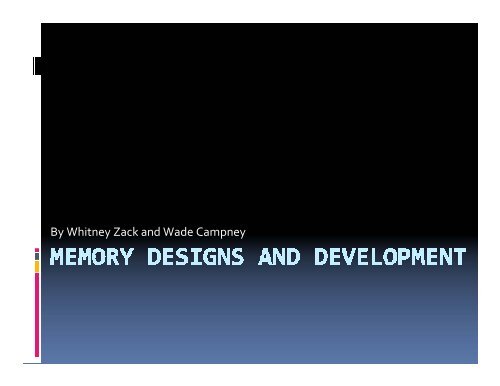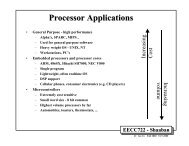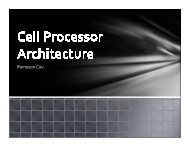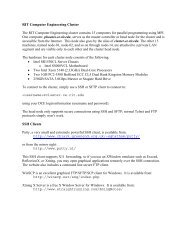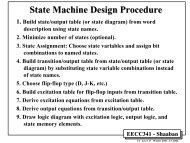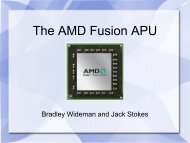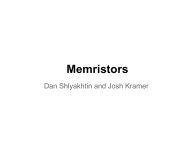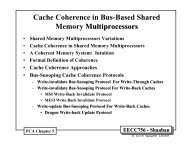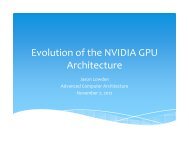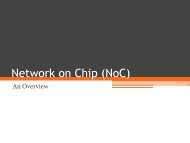By Whitney Zack and Wade Campney
By Whitney Zack and Wade Campney
By Whitney Zack and Wade Campney
Create successful ePaper yourself
Turn your PDF publications into a flip-book with our unique Google optimized e-Paper software.
<strong>By</strong> <strong>Whitney</strong> <strong>Zack</strong> <strong>and</strong> <strong>Wade</strong> <strong>Campney</strong>
Key points<br />
• Problem with Memory<br />
• Non‐Volatile Memory<br />
MRAM<br />
• Volatile Memory<br />
SRAM<br />
DRAM<br />
• Hybrid/Hyper Memory Cube (HMC)<br />
Design<br />
Performance
RAM
The Problem with Memory<br />
• Memory performance is not scaling to<br />
Moore’s Law (CPU performance.)<br />
• This creates a bottleneck in performance.<br />
• Some call this a “memory wall”<br />
• Conventional memory architectures Memory<br />
I/O performance/b<strong>and</strong>width cannot keep up<br />
• Problems with heat <strong>and</strong> power consumption<br />
when adding more memory or moving it<br />
closer to CPU
Non‐Volatile<br />
• Is computer memory that can retain the<br />
stored information even when not powered<br />
MRAM<br />
FeRAM<br />
PRAM
MRAM: “Universal Memory”<br />
• Magnetoresistive R<strong>and</strong>om Access Memory<br />
• Magnetic cells instead of electric charge<br />
• Slower than SRAM<br />
• Low voltage, <strong>and</strong> low cell leakage.<br />
• Similar density compared to DRAM
MRAM Drawbacks<br />
• Requires a lot of current to write to memory<br />
• Requires big cell size to prevent the ‘halfselect<br />
problem’<br />
• No plans for FAB quite yet due to other<br />
memory dem<strong>and</strong>s(Flash/DRAM)
MRAM: Toggle Mode<br />
• Cell is modified to contain an artificial<br />
antiferromagnet layer.<br />
• Resulting layers only have two stable states,<br />
which can be toggles by skewing the write<br />
currents to “rotate” the field.<br />
• This fixes the half‐select problem <strong>and</strong> allows<br />
for smaller MRAM cells.
MRAM: Toggle Mode(PIC)
MRAM: Spin Transfer Torque<br />
• This method uses spin‐aligned electrons to<br />
directly torque the domains.<br />
• Lower amount of current required to write to<br />
the cells.<br />
• Allows for even smaller cell sizes(~65nm),<br />
which allows for a higher density.
MRAM Spin Transfer(PIC)
Volatile Memory<br />
• Retaining data only as long as there is a<br />
power supply connected<br />
SRAM<br />
DRAM<br />
Hybrid Memory Cube
SRAM(Static RAM) drawbacks<br />
• 4‐6 transistors to create a single bit of SRAM<br />
• SRAM takes up much more space than DRAM<br />
• SRAM is byte for byte more expensive than<br />
DRAM<br />
• No leaking like in DRAM so there is no need<br />
for refresh circuit<br />
• Flip Flop design allows for instantaneous<br />
written instead of capacitor fill up like DRAM
DRAM(Dynamic Ram) drawbacks<br />
• 1 transistor <strong>and</strong> 1 capacitor<br />
• Low cost per bit<br />
• Higher memory density of SRAM<br />
• High Power consumption because of refresh<br />
circuit<br />
• Heat problems
HMC – In Development<br />
• Intel/Micron originally researched<br />
• Micron/Samsung/IBM created consortium<br />
• Uses TSV (Through Silicon Via) to stack<br />
memory vertically.<br />
• Low power consumption<br />
• Small Size<br />
• Specs to be released in 2012
Some Specs<br />
• 15X b<strong>and</strong>width of DDR3<br />
• 70% reduction in energy per bit than DDR3<br />
• Reduced latency with lower queue delays,<br />
<strong>and</strong> increased number of banks.<br />
• System Architecture makes it extremely<br />
efficient on space.
Design
Actual Picture
DRAM 512 MB Memory Stick
512 MB Memory Cube
1 TB/s HMC DRAM Prototype
B<strong>and</strong>width Performance
Power Performance
The Future<br />
• Intel speculates super computer by 2018 that<br />
can operate at exaflop performance (10 18 )<br />
• Will probably be seen first in graphics for<br />
memory performance improvement<br />
• Adaptable to many types of systems because<br />
of logic layer<br />
• Potential for first universal memory<br />
(Personal/home computing, Commercial use)
Questions, Comments, etc…<br />
• Thank you


